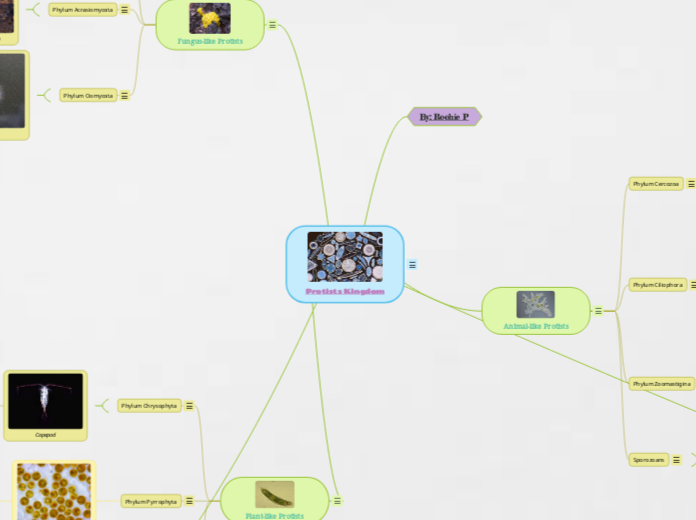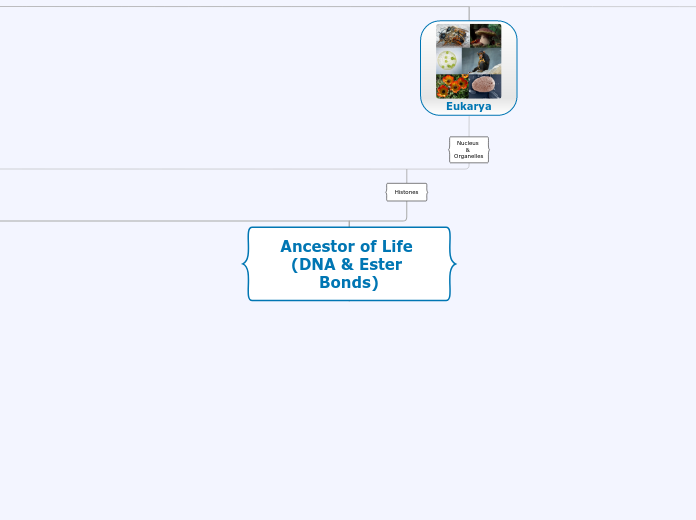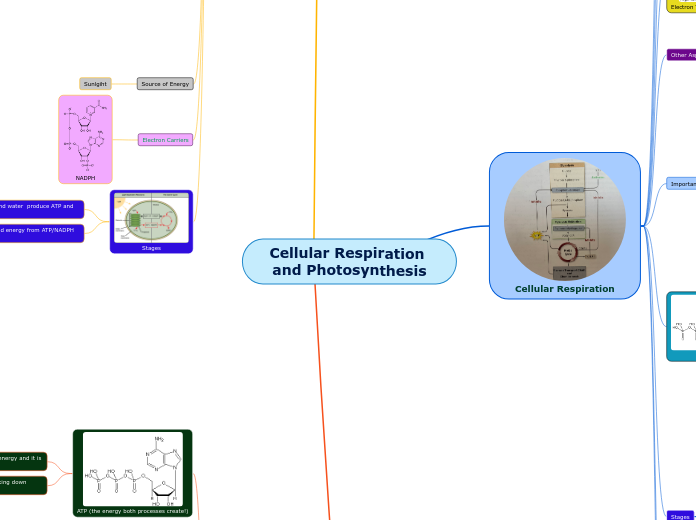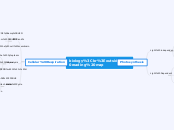Plasmodium
Paramecium caudatum 40x
Paramecium caudatum 100x
Paramecium caudatum 400x
Amoeba proteus 40x
Amoeba proteus 100x
Amoeba proteus 400x
Spirogyra 40x
Spirogyra 100x
Spirogyra 400x
Pseudoplasmodium
Achlya
Sarcomastigophora
Classified into 3 Phyla by molds
Eimeria
Monocots vs. Dicots
Monocots:
- Have scattered vascular bundles
- Leaves with 3 petals
- 1 seed leaf (cotyledon)
- Parallel Veins
Dicots:
- Vascular bundles are in rings
- Layout resembles a cross-like form
- 2 seed leaves (cotyledons)
- Leaves with 4-5 petals
- Network veins
Copepod
Plankton from Spongebob -->
Classified into 4 Phyla by movement
Euglena 40x
Euglena 100x
Euglena 400x
Classified into 3 Phylum by multiple characteristics
Protists Kingdom
Protists are eukaryotic organisms that do not fit into the other eukaryotic kingdoms (Animalia, fungi, plantae). These commonly unicellular (except for algae) organisms are then classified in a sort of "miscellaneous" group called "Protista." There are few multicellular protists, however, they do not form true tissues. Most protists reproduce asexually. They are based on their nutrition.
Multicellular Algae
Algae: Multicellular plant protists
-Red, Brown and Green Algae.
Plant-like Protists
Plant-like protists can perform photosynthesis. They contain chlorophyll and can be multicellular (algae) or unicellular (diatoms, etc.). These organisms supply half of the world's oxygen and are also the primary source in aquatic food chains! Additionally, they can be used to make Agar which is used in the medical industry.
Phylum Euglenozoa
Phylum Euqlenozoa: Euglenoids
-Are autotrophs in the sunlight but heterotrophs in the dark
-Have eyespots to detect light
e.g. Euglena
Phylum Pyrrophyta
Phylum Pyrrophyta: 2 flagella at right angles.
-Some cause algal bloom (red tide) which can be toxic to humans/marine animals, shellfish etc.
-Has bioluminescence (production of light in organisms)
e.g. Symbiodinium lives inside coral
Symbiodium
Red Tide
Phylum Chrysophyta
Phylum Chrysophyta: Diatoms (phytoplankton)
-They are abundant and very diverse, making them a commmon food source for marine organisms.
-Have rigid cell walls and an outer layer with silica.
e.g. Copepod *yes like Plankton from Spongebob!*
Fungus-like Protists
Also called "Molds," fungus-like protists are heterotrophic (they absorb nutrients from waste, living and the dead). Unlike regular fungi, these protists either lack a cell wall, or have cellulose in it. They produce fungus that is spore-like, water mold and slime molds. They are divided into 3 groups based on the mold.
Phylum Oomycota
Phylum Oomycota: water molds
-Has a form of threads/hairy (filamentous)
-Some of them are parasitic (extends its threads into their host's tissue to absorb nutrients)
e.g. Achlya
Phylum Acrasiomycota
Phylum Acrasiomycota: cellular slime mold
-Has individual amoeboid cells with 1 nucleus each
-Ingests yeast or bacteria
-When food is scarce, pseudoplasmodium forms.
Phylum Myxomycota
Phylum Myxomycota: plasmodial slime mold
-Resembles dog vomit
-Creeps over decaying material and is slug-like.
-Exists like a streaming blob called plasmodium (it contains many nuclei)
Domain Eukarya
Domain Eukarya:
All living organisms made up of (one or more) complex eukaryotic cells (cells with a complex structure and more organelles). These include the four main kingdoms: Animalia, Protista, Plantae and Fungi.
Animal Kingdom
Kingdom Animalia:
- Multi-cellular organisms
- Cells have no cell wall
- Heterotrophs: commonly ingest and digest their food.
- Commonly mobile (even at least in one stag of their lives)
- Reproduces sexually (commonly)
- Produces an offspring
- Divided into two categories of invertebrates and vertebrates
- Divided into 35-36 phyla
Are classified based on 8 qualities:
- Presence of backbone
- Vertebrates: have a backbone
- Invertebrates: don't have a backbone (95% of animals)
- Levels of Organization
- Different levels of complexity and structures
- Varying complexity of bodily systems like repiratory, digestive, etc.
- All animals have cells that are organized into tissues besides sponges.
- Body Layers
- All animals have three body layers:
- Ectoderm: Outer layer (skin, etc.)
- Mesoderm: Middle layer (muscles, etc.)
- Endoderm: Inner layer (organs like liver, etc.)
- Sponges and cnidarians do not have 3 body layers
- Body Symmetry
- Majority of animals are symmetrical
- Two types of symmetry:
- Radial symmetry: body parts go around one axis point
- Bilateral symmetry: body is equal in halves like a mirror image (if you were to put a line through the middle, both sides would look the same)
- Body Cavity
- Coelom is a body cavity that is filled with fluid and organ systems
- Two types:
- Coelomates: have a coelom (insects, etc.)
- Acoelomates: don't have a coelom (jellyfish, etc.)
- Segmentation
- The body dividing into segements or repetitive sections
- The undamaged segements can still work
- Have complex patterns of movement
- Movement
- Divided into 2 types:
- Motile: can do locomotion (majority of animals)
- Sossile: stays stationary (sea anemone, etc.) (however, in its earlier stages of life it is often motile)
- Reproduction
- Sexual reproduction
- Asexual reproduction (different types):
- Fragmentation (like a starfish's arm breaking off to make a new starfish.)
- Budding (hydra)
Phylum Chordata, Subphylum Vertebrata
Class Mammalia
Mammalia:
Have...
1. Hair (marine animals have a little)
2. Specialized Teeth
3. Endothermic (warm-blooded)
4. Mammary Glands
5. Placenta (most): placental mammals spend some time in the uterus
6. Diaphragm - muscle that aids breathing
- Give birth to live youngs except..
- Monotromes: Lay eggs (duck-billed platypus)
- Marsupials: develop their youngs in their pouch (kangaroos)
Ex. tigers, dogs, whales, bats
Class Aves
Aves:
- Back bones
- Feather
- Warm blooded
- Fly, swim, ground dwelling
- Bills
- No teeth
- Lay eggs
- Light, hollow bones
- 9.6k species
- Descended from dinosaurs
Ex. Falcons
Class Reptilia
Reptilia:
- First class to adapt life on land
- 10k species
- Cold blooded
- Powerful jaw
- Light skull
Ex. Turtles, snakes
Class Amphibia
Amphibia:
- Part life on water, part life on land
- 4 legs
- No amniotic eggs
- Lay eggs in water
- Gills
- Metamorphosis helps it grow lungs and legs
- 5.7k species
Eg. Frogs, salamanders
Class Chondrichthyes
Chondrichthyes:
- 1k species in this class
- Made of cartilage (no bone)
- Teeth and vertebrae have calcium
- Egg cases or live young (majority)
- Assumed to have existed 400 million years ago (before dinosaurs)
- 1k species of sharks and rays
Ex. Sharks, skates, rays
Class Osteichthyes
Osteichthyes:
- Jawed fish
- Largest class of vertebrates
- 29k species of bony fish
- Swim bladder: filled with gas for buoyancy
- Scales
- Lateral line
- Sensory organs
Ex. Eels, Anglerfish
Class Agnathans
Agnathans:
- Jawless fish
- Probably earliest vertebrates
- Fossils from 500 million years ago
- Don't have paired fins/stomach
- Skeleton made of cartilage
- Fertilization of eggs takes place outside of the body
Ex. Lamprey, Hagfish
Invertebrates
Phylum Chortada
Phylum Chordata:
- Bilateral symmetry
- 6k species, half of which are bony fish
- Deuterostomes: Anus forms before mouth in embryo stage
- Fluid filled body cavity
- Notochords
Subphylum Cephalochordate:
- Lancelets (amphioxus)
- Small, "vaguely fish-shaped" animals that lack brains
- Clearly defined heads
- Special sense organs
- 25 species in marine environment
- Filter feeders
Subphylum Tunicata:
- Sea squirts, larvaceans
- Both are soft bodied filter feeders
- Sessile: mainly water pumps and filter-feeding apparatus
Subphylum Vertebrata:
- Chordates with the notochord replaced by a vertebral column during development
Phylum Anthropoda
Phylum Anthropoda:
- Bilateral Symmetry
- Fly, crawl, walk, scurry
- Terrestrial: internal fertilization
- Aquatic: internal/external fertilization
- All lay eggs
- Aphid give birth to live young
- Exoskeleton made of chitin
- Segmented bodies
- Paired/joint appendages
- Wings
Ex. Spiders
Phylum Mollusca
Phylum Mollusca:
- Bilateral symmetry
- External fertilization (lay eggs)
- Internal fertilization (hermaphrodites')
- Muscular mouths with radulae
- Largest marine phylum
- Most neurologically advanced invertebrates
Ex. Colossal Squid
Phylum Annelida
Phylum Annelida:
- Bilateral symmetry
- Crawl or swim
- Have tiny hairs that work as paddles
- Sexual and asexual reproduction
- Hermaphrodites
- Eat microscopic critters in soil
- Have mouths
- Body made of linked segments
- Closed circulatory system
Ex. Leeches
Phylum Nematoda
Phylum Nematoda:
- Round worms
- Bilateral symmetry
- Crawl or swim
- Sexual and asexual reproduction
- Hermaphrodites'
- Have true digestive system open at both ends (mouth and anus)
- Parasites
Ex. Tape worms
Phylum Platyhelminthes
Phylum Platyhelminthes:
- Bilateral Symmetry
- Movement: Crawl or Swim
- Reproduction: Sexual and asexual (some are hermaphrodites)
- Nutrition: Scavengers or parasitic
- Invertebrates
- Flattened bodies
- Loong/narrow bodies
Ex. Planaria
Planaria whole-mount, 40x
Planaria cross-section, 40x
Phylum Echinodermata
Phylum Echinodermata:
- Radial symmetry
- Movement: Tube feet
- Reproduction: Asexual (like fragmentation)
- Can sometimes regenerate limbs
- How they eat: Fluid filled canals
- 7k Living species
Ex. Starfish'
Phylum Cnidaria
Phylum Cnidaria:
- Asymmetric
- Movement: forces water out that propels them forward.
- Reproduction: Sexual (eggs), Asexual (releases gametes)
- Digestion: Orrifice and body cavity
- Sting with tentacles, take and eat their food
- 11k species of aquatic life
Ex. Jellyfish'
Hydra with bud, 40x
Phylum Porifera
Phylum Porifera:
- Asymmetric
- Movement: sinks spicules in ground and pull to haul body forward
- Reproduction: Both sexes are in one sponge (internal or external fertilization)
- How they eat: Filter feeding
- First animals
- No tissues/organs
Ex. Sea sponges
Plant Kingdom
Kingdom Plantae:
- Multi-cellular organisms
- Are made up of eukaryotic plant cells which include large vacuoles, chloroplasts and cell walls with cellulose.
- Autotrophs: Make their own food by doing photosynthesis (produce C6H12O6)
- Are immotile
- They store food as starch.
- Plants are classified as vascular or non-vascular plants.
- They then narrow down the classification of vascular plants to seed and seedless.
Mixed pollen, 400x
Vascular
Vascular:
- Plants with xylem and phloem tubes that are used as transportation vessels.
- More successful because they have a stronger structure thanks to the tubes, and transport water better.
- Xylem tissues carry the water/minerals, while the phloem tissues carry glucose (C6H12O6)
Have three main structures:
- Roots: anchor the plant, get water/minerals from the soil, can also store the food energy as starch. Divided into three main types:
- Fibrous root
- Tap root
- Adventitious
- Stems: Support the leaves and flowers (while supporting them in the best position to reproduce and get food), use the xylem and phloem to get materials of high volume in one part to spread out into others and can store nutrients for the future. Divided into three outer arrangements:
- Opposite
- Alternate
- Whorled
- Leaves: They maximize the surface area of the plant for photosynthesis, control the stoma (opening that releases, takes in gases). Vary in shapes.
- Flowers, spores and cones are also additional structures of a plant.
Stomata leaf epidermis, 100x
Monocot: Zea mays leaf, 100x
Lilium stem, 100x
Monocot: Elodea leaf whole-mount , 100x
Monocot: Zea mays stem, 100x
Dicot: Syringa leaf, 100x
Dicot: Ranunculus root, 100x
Dicot: Tilia stem, 40x
Fern leaflet, 100x
Seed
Seed Plant:
- Use seeds for reproduction
- A seed is considered a plant embryo
Seed plants are divided into 2 groups of seed bearing/forming vascular plants:
Gymnosperms
Gymnosperms:
- Cone bearing plants
- Use their sexual reproductive organs to reproduce naked seeds.
- Pollinate by having their pollen get carried by wind to female cones which produces seeds.
- These seeds are protected and they then fall, germinate and become new trees themselves.
Ex. Spruce trees
Angiosperms
Angiosperms:
- Flower bearing plants
- Produces protected seeds
- Pollinated by spreading the pollen from one stigma to another, known as cross-pollination or to the same plant, known as self-pollination.
- The pollen is spread by bees, wind, ...
- Another method is a sperm travelling down a pollen tube that is in the style of a plant until its ovaries.
- The plant egg in the ovaries are than fertilized and develop a seed
Ex. Tulips
Angiosperms are then divided into 2 types based on its vascular bundle layout:
Seedless
Seedless Plants:
- Are reproduced by spores
- Require water in order to reproduce
Ex. Ferns
Non-Vascular
Non Vascular:
- No vascular tissues, no stems, no leaves, no roots
- Smaller than vascular plants
- Use osmosis and diffusion to transport
- Have a small root-like structure called: "Rhizoida"
Ex. Mosses
Fungi Kingdom
Kingdom Fungi:
- Originally considered to be part of the Plantae kingdom until fungi were observed to not photosynthesize like plants do.
- With differences like: no leaves, no true roots, no cellulose, etc. these organisms were given a separate Kingdom.
- Fungi can be uni or multi-cellular organisms that are essentially heterotrophs (absorbs nutrients into cells by releasing digestive enzymes around them).
- Fungi breakdown organic material and are vital to a healthy environment and it is known as being "saprophytic."
- A fungus can be either (or more than one) parasitic (absorbs the nutrients from their host), predatory (traps prey), mutualistic (they are partnered up with other fungi or plants, and benefit off each other) or saprobial (breaks down and consumes dead organisms and organic material).
- Fungi are also beneficial medicinally, and can be used as psychedelics or even contributed to inventions like the antibiotic: Penicillin.
- Fungi do not have cell with with cellulose, but rather chitin.
- The structure of a fungi (multi-cellular), consists of a thread-like base called the Hyphae, a net-like mass off branching hyphae called Mycelium and their reproductive system called the Fruiting body (mostly what people see as mushrooms).
- Fungi can reproduce asexually (fragmentation, budding, releasing spores) or sexually (producing gametes).
- Despite being divided into these kingdoms, fungi are additionally divided into their 5 phylum:
- Fungi Imperfecti
- Chytrids
- Zygospors
- Sac Fungi
- Club fungi
Club Fungi
Club Fungi:
- Mushrooms (commonly)
- Have fruiting bodies but they're often short-lived
Ex. Agaricus bisporus, mushrooms dissected in class.
Coprinus, 400x
I took this photo using Mariam's microscope because I was told that it had a better example. :)
Mushroom Hyphae, 40x
Mushroom Cap, 400x
Mushroom Gills, 40x
Sac Fungi
Sac Fungi:
- The most common and largest phylum of fungi.
- Have finger-like sacs
- Yeasts
Ex. penecillium, related to penicillin which is a famous antibiotic in the medical field!
Zygospores
Zygospores:
- Multicellular fungi that are terrestrial instead.
Ex.
rhizopus, a fungi that causes mold on bread.
Rhizopus sporangia, 40x
Chytrids
Chytrids:
- Majority unicellular fungi that have flagella, spores, and are commonly aquatic.
Ex. Synchytrium endobioticum, a fungi that grows on to organisms and causes the potato wart.
Fungi Imperfecti
Fungi Imperfecti:
- A diverse variety of fungi with no sexual structure.
Ex.
Trichophyton rubrum, a fungi that causes Athlete's foot!
Animal-like Protists
Also known as Protozoa, animal-like protists are heterotrophic. These organisms consume other organisms (protozoa, prokaryotes, organic wastes, etc.). Some species of animal-like protists are parasites. Animal-like Protists are divided into 4 Phyla by its movement.
Sporozoans
Sporozoans: parasitic
-Takes nutrients from its host
e.g. Eimeria, causes Coccidiosis
Phylum Zoomastigina
Phylum Zoomastigina: Flagelettes
-Have flagella (like a tail that lets a protist move)
e.g. Sarcomastigophora, causes a disease in the small intestines called Giardiasis.
Phylum Ciliophora
Phylum Ciliophora: Ciliates
-Have cilia (like hair)
E.g. Paramecium caudatum
Phylum Cercozoa
Phylum Cercozoa: amoebas
-Have pseudopods "fake feet."
E.g. Naegleria fowleri, a deadly brain eating amoeba.
By: Roohie P









